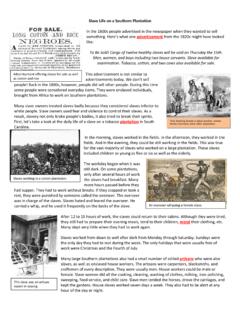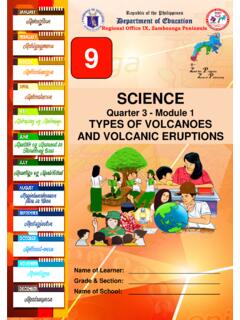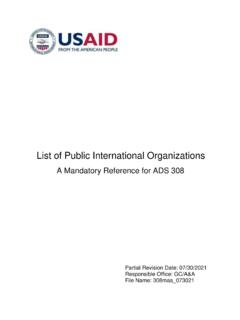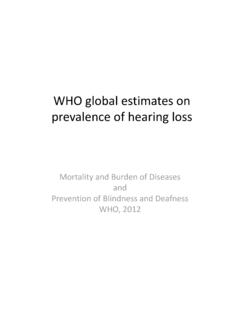Transcription of EUROPEAN EXPLORATION 1400 1500 (Adapted from …
1 EUROPEAN EXPLORATION 1400 1500 (Adapted from Discovery Education) Why did Europeans first arrive in the Americas? In the 1400s and 1500s, there was a new love for culture and scientific discovery in Europe named the Renaissance. During this time, people used scientific examination to explore how the natural world worked. This curiosity and spirit of discovery, which led to numerous inventions and scientific discoveries during the Renaissance, also led to a period of geographic EXPLORATION as individuals began to explore the seas and lands beyond Europe. Although the ideas of the Renaissance contributed to the EXPLORATION of new lands, more practical concerns were also at play. During this period, many EUROPEAN nations were in constant conflict with each other as they struggled to increase their power and wealth.
2 Many of these nations believed trade with other countries was the best way to increase wealth. However, many of the land routes that were used for trade with Asia were controlled by other countries that blocked direct trade between EUROPEAN and Asian nations. As a result, EUROPEAN leaders began to seek new sea routes to Asia. EUROPEAN leaders like Spain's King Ferdinand and the Portuguese prince known as Henry the Navigator financed explorers who wanted to travel across the seas. Along with the idea of looking for new trade routes, they also hoped to find new sources of gold, silver, and other valuables. Additionally, Europeans saw EXPLORATION as a way to bring Christianity to other cultures that lived in other lands. While some explorers sailed around Africa to Asia, others thought they could find a quicker route by sailing west.
3 These voyages led to the unexpected discovery of new lands, as sailors bound for Asia came to the Caribbean islands and the continents of North America and South America. Europeans Arrive in the Caribbean On August 3, 1492, Christopher Columbus set sail from Palos, Spain, with three ships: the Ni a, Pinta, and Santa Maria. Columbus intended to cross the Atlantic Ocean to find a quicker sea route to Asia. On October 12, 1492, men on the Pinta saw land. Although Columbus and his men thought they had reached Asia, they actually landed on what would later be known as Watlings Island in the Bahamas. For three months, Columbus and his men explored the islands of the Caribbean, landing on the islands of Cuba and Hispaniola (the island that contains the modern-day countries of Haiti and the Dominican Republic).
4 Columbus and his men also met the native peoples of these islands , the Taino. By During the Renaissance, people became more interested in science. Europe suffered many wars in the 1400s and These were the most common trade route between Europe and Asia in the 1400s. Portrait of Christopher Columbus who discovered the Americas. Columbus three ships: the Ni a, Pinta, and Santa Maria. 1494, the Spanish, led by Columbus, had established a permanent settlement on Hispaniola and begun their conquest of the island. As a result of these first encounters in the Caribbean, Europeans from different nations explored, settled, and conquered the Americas over a period of about 300 years. Competition for EXPLORATION led to a treaty between Spain and Portugal in 1494, which gave Spain the exclusive right to explore and conquer almost all of the land in the Americas.
5 The treaty gave Portugal the right to explore and conquer lands in Africa, Asia, and the land in South America that would become Brazil. Despite the discoveries in the Americas, the search for a sea route to Asia continued. In 1519, Ferdinand Magellan launched five ships from Spain and navigated around the southern tip of South America. Although he died in 1521, his expedition continued without him. The first sailors to travel around the entire globe, Magellan's expedition returned to Spain in 1522 and proved that the world was indeed round. The sea channel that Magellan took between the Pacific Ocean and the Atlantic Ocean was named the Strait of Magellan. During this important Age of EXPLORATION , two vastly different worlds intersected: the Americas and Europe. The exchange of people, ideas, plants, animals, technologies, and diseases between these two worlds shaped their history for the next 500 years.
6 Conquering the Americas How were the Spanish able to conquer Native American populations? During the 100 years following Columbus s first voyage to the Americas, Spanish conquistadors, explorers, and soldiers conquered and claimed much of the Americas for Spain. These men fought for many reasons. One reason is that EXPLORATION and conquest could lead to great wealth. Other people came because they were faithful Catholics and wished to convert Native Americans to Christianity. Still others loved the idea of an adventure in new places. Several factors helped the Spanish conquer the native populations. One factor that aided the Spanish was their weapons. Using sophisticated, strong weapons such as steel swords, crossbows, and guns helped the Spanish against local people, who had less powerful weaponry.
7 The Spanish conquistadors also had horses, which people in the Americas had never seen before. Fighting on horseback gave the Spanish explorers an advantage over the Native American populations, who fought on foot. Map of Columbus first journey to the Americas. Portrait of Ferdinand Magellan. Location of the Strait of Magellan. Spanish conquistadors. Weapons used by the Spanish conquistadors. However, one of the most important tools that the Europeans had was one they did not even know they had brought with them to the Americas disease. EUROPEAN explorers carried over several diseases that Native Americans had never encountered before. One such disease was smallpox, a highly contagious disease that had existed in Europe for thousands of years. Over time, the Europeans developed some resistance to it.
8 Native Americans, though, had never encountered the disease and therefore had no resistance to it. As a result, smallpox killed the Native American populations that encountered it. The effects of smallpox helped two of the most famous conquistadors, Hern n Cort s and Francisco Pizzaro. Despite commanding forces that were significantly smaller than those of the Aztec and Incan armies, these two conquistadors were still able to conquer the powerful empires. Smallpox was a deadly disease for Native Americans. Thousands died because of this disease. t

















